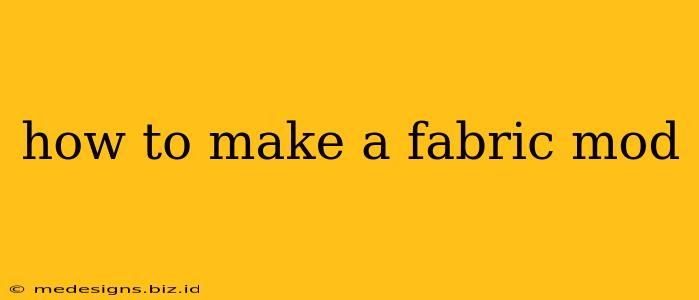So you want to learn how to make a Fabric mod? That's fantastic! Fabric is a popular modding loader for Minecraft, known for its ease of use and powerful features. This guide will walk you through the process, from setting up your development environment to deploying your first working mod.
Setting Up Your Development Environment
Before you can start coding, you'll need the right tools. This includes:
-
Java Development Kit (JDK): Fabric mods are written in Java. Download and install the appropriate JDK version for your operating system. Make sure to set the
JAVA_HOMEenvironment variable correctly. This is crucial for your development tools to find the JDK. -
An Integrated Development Environment (IDE): An IDE provides a user-friendly interface for writing, debugging, and managing your code. Popular choices include:
- IntelliJ IDEA: A powerful and widely used IDE with excellent Java support and a robust plugin ecosystem. The community edition is free and perfectly suitable for Fabric modding.
- Eclipse: Another strong contender, offering a large community and plenty of plugins.
- VS Code: While not a dedicated Java IDE, VS Code with the right extensions can provide a surprisingly good development experience.
-
Fabric Loader: This is the essential component that allows your mod to load into Minecraft. You'll need to download the appropriate version for your Minecraft version.
-
Fabric API: The Fabric API provides crucial utility functions and simplifies many common modding tasks. This is almost always a required dependency for your mod.
Installing Necessary Software and Setting up your project:
-
Install Java: Download and install the latest LTS (Long Term Support) version of the JDK from Oracle's website or a similar reputable source.
-
Install Your Chosen IDE: Download and install IntelliJ IDEA (Community Edition recommended), Eclipse, or VS Code.
-
Create a new Project in Your IDE: Most IDEs provide templates or wizards to create new Java projects. Choose an appropriate project structure. You will want to use a build system like Gradle or Maven. Fabric's documentation highly recommends Gradle.
Creating Your First Fabric Mod
Let's create a simple "Hello World" mod to get you started. This will involve creating a basic mod class that registers itself with Fabric.
1. The fabric.mod.json file
This is the heart of your Fabric mod. This JSON file tells Fabric about your mod. It includes details such as the mod ID, name, version, and dependencies (like the Fabric API). A basic example:
{
"schemaVersion": 1,
"id": "myhelloworldmod",
"version": "1.0.0",
"name": "My Hello World Mod",
"description": "A simple 'Hello World' mod for Fabric",
"authors": [
"Your Name"
],
"contact": {
"sources": "https://github.com/yourusername/myhelloworldmod" //Optional GitHub Link
},
"license": "MIT",
"environment": "*",
"entrypoints": {
"main": [
"com.yourcompany.myhelloworldmod.MyHelloWorldMod"
]
},
"depends": {
"fabricloader": ">=0.14.21",
"fabric": "*"
}
}
Remember to replace placeholders like "com.yourcompany.myhelloworldmod.MyHelloWorldMod" with your actual package name and class name.
2. The Main Mod Class
This Java class will contain the core logic of your mod. This is where your mod registers itself with Fabric and performs its actions.
package com.yourcompany.myhelloworldmod;
import net.fabricmc.api.ModInitializer;
import net.fabricmc.fabric.api.client.itemgroup.FabricItemGroupBuilder;
import net.minecraft.item.ItemGroup;
import net.minecraft.item.ItemStack;
import net.minecraft.util.Identifier;
import net.minecraft.util.registry.Registry;
import org.slf4j.Logger;
import org.slf4j.LoggerFactory;
public class MyHelloWorldMod implements ModInitializer {
// This logger is used to write text to the console and the log file.
public static final Logger LOGGER = LoggerFactory.getLogger("MyHelloWorldMod");
public static final ItemGroup MY_ITEM_GROUP = FabricItemGroupBuilder.build(new Identifier("myhelloworldmod", "my_item_group"), () -> new ItemStack(Items.DIAMOND));
@Override
public void onInitialize() {
LOGGER.info("Hello Fabric world!");
}
}
This code will print "Hello Fabric world!" to the console when your mod loads.
3. Building and Running Your Mod
Once you have the fabric.mod.json and your main mod class, use your IDE's build system (Gradle) to compile your mod. This will generate a JAR file containing your mod.
Place this JAR file in your Minecraft mods folder. Launch Minecraft with Fabric Loader, and you should see your "Hello Fabric world!" message in the console.
Expanding Your Mod
This is just the beginning! Once you have a basic mod working, you can expand its functionality by:
- Adding Items: Learn how to create and register new items with their recipes.
- Adding Blocks: Create custom blocks with unique textures and behaviors.
- Adding Entities: Introduce new creatures or objects into the game world.
- Modifying Game Mechanics: Explore ways to alter existing game systems.
This guide serves as a starting point for your Fabric modding journey. Refer to the official Fabric documentation for more detailed information and advanced techniques. Remember to always back up your work and explore the vast resources available online. Happy modding!
